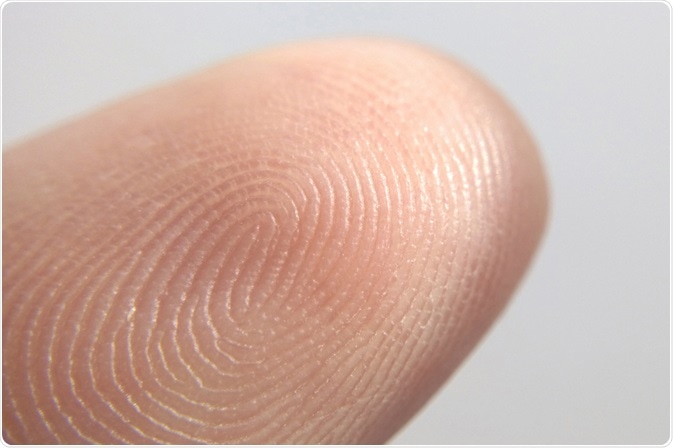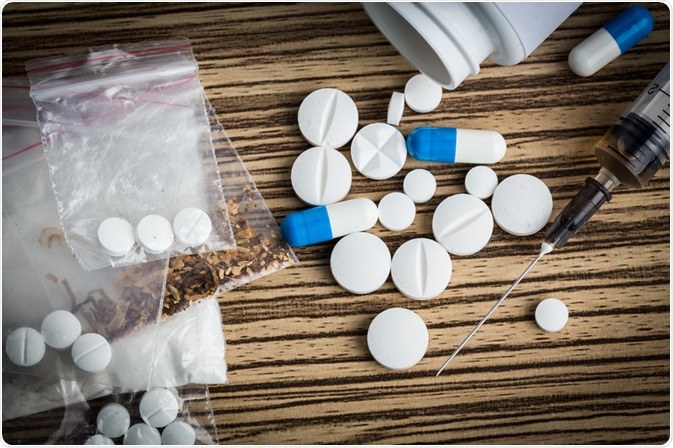While drug-testing analysis using biological matrices of blood, saliva, and hair are commonplace in forensic laboratories, the techniques used to generate the results are cumbersome, time-consuming, and expensive.

Image Credit: Bondar Pavel/Shutterstock.com
Fingerprints, which are commonly known for their ridge details to link a suspect to a crime scene and/or victims, can now be used as a tool to detect the presence of illicit drugs that have been consumed by the individual.
Infrared Spectral Imaging can detect substances on fingerprints
Different studies have shown the successful detection of trace materials left on fingerprints deposited on various surfaces. Crane et. al analyzed the residues left on fingerprint deposited on a postcard, while Chan et al. detect those deposited on the ATR crystal by ATR-FTIR.
The studies revolving around the detection of these materials provided the possibility of detecting contaminants such as drugs on the fingerprints to indicate the usage or exchange of drugs by individuals.
In a more recent study, Ng, et al. uses the FTIR spectrometer coupled with an infrared microscope to analyze samples of fingerprints containing a drug substance. The study analyzes these fingerprints in a reflection mode for those deposited on an infrared-reflective slide, and transmission mode on those deposited on the silicon windows.
The images were then captured and the scans were collected between the range of 4000 to 900 cm-1. Each spectrum was then searched against a spectral reference database consisting of organic compounds. From the spectra of the image, they could identify illicit drugs such as cocaine at 2893 cm-1.
The “hit map” feature shows the area where the cocaine was detected on the fingerprint by using a commercial search software to find a cocaine reference spectrum to compare the observed spectrum to.
Fluorescent nanoparticles on detecting ketamine and amphetamine
Illicit drugs such as amphetamine and ketamine on fingerprints can be detected by nano carrier-based biological fluorescent probes (BFP). This particular method can detect the presence of these drugs on fingermarks through conjugation of the fluorescence nanoparticles with the antibodies.
High sensitivity, as well as selectivity, can also be achieved by using this technique to the detection limit of 50 ng for ketamine or amphetamine on the fingerprints.
The biological fluorescent probe for each amphetamine and ketamine was applied to the corresponding fingerprint with the substances and incubated at 37 ℃ for 30 min in an immunohistochemical wet chamber. The latent fingerprints were then imaged using the appropriate excitation wavelength and emission filters.
They found that BFPs can selectively bind to the fingerprint ridges to indicate which drug is present on the fingerprint. Fingermark containing ketamine gives a red fluorescence image, while the one with amphetamine generates a green fluorescence image in their corresponding color images. While fingermarks with no drugs used as the negative control yield a dark color, signifying the absence of ketamine or amphetamine.
Furthermore, the minutiae of the fingerprint can clearly be observed for identification purposes of the person of interest. Multiple drugs can also be detected in a single fingermark with the aid of the different colors of fluorescent nanoparticles in the respective channels. This allows the detection of more drugs other than ketamine and amphetamine, by using their specific antibodies.
Raman spectroscopy can identify drugs on oil-rich fingerprints
Day et al. found that the Raman spectra was able to identify the doping agent on the fingerprints regardless of the amount of oil substance from the fingerprints. This serves as an advantage as some people may secrete sebum more than others and this may interfere with the quality of the dopants identification in these prints.
However, the exact location of the drug on the fingerprint plays a crucial role in identifying the presence of the drug particles using Raman spectroscopy. The additional solid particles found on the latent fingerprint may interfere with the visualization of these drug particles, especially when there is less amount of drug or adulterant in the fingerprint. The exogenous substances found in fingerprints can be located through Raman imaging.

Image Credit: FabrikaSimf/Shutterstock.com
Excretion of specific drugs through sweat on fingerprints
As some drugs are usually secreted through the eccrine glands that are mainly found on the ridges of hands and feet, their presence can be detected through this excretion. Methamphetamine, amphetamine, cocaine, and ethyl methyl ecgonine can be detected in sweat two hours after consumption. Basic compounds with low molecular weight can be detected in sweat due to their ability to diffuse through the cell membranes.
Nevertheless, the doses intake may influence the detection of these drugs in sweat as well as the varying response from every individual that consumes the drug. Barnes et al. found that amphetamine was not detected after a 10-mg of methamphetamine was consumed on the first day. However, this drug was found in the sweat of a consumer after 20-mg of consumption in just 2 hours.
In addition, amphetamine and methamphetamine can be excreted even after 1 week if the consumption of multiple uses of the drug is stopped abruptly. Another drug, cocaine, cannot be detected in a fingerprint after more than 48 hours of contact or ingestion.
While there is no clear indication on whether the individual has been in contact with or has ingested cocaine, handwashing of the individual before drug detection on fingerprints can be done to determine if the individual has only been handling the drug without ingestion.
References
- Ng, P.H.R., Walker, S., Tahtouh, M., and Reedy, B., 2009. Detection of illicit substances in fingerprints by infrared spectral imaging. Analytical and bioanalytical chemistry, 394(8), pp.2039-2048. https://pubmed.ncbi.nlm.nih.gov/19424685/
- Zhou, J., Zhao, G., Lu, W., Zhan, L., and Han, G., 2019. Nanocarrier-Based Biological Fluorescent Probes for Simultaneous Detection of Ketamine and Amphetamine in Latent Fingermarks. Nano, 14(02), p.1950026. https://www.worldscientific.com/doi/pdf/10.1142/S1793292019500267
- Barnes, A.J., Smith, M.L., Kacinko, S.L., Schwilke, E.W., Cone, E.J., Moolchan, E.T., and Huestis, M.A., 2008. Excretion of methamphetamine and amphetamine in human sweat following controlled oral methamphetamine administration. Clinical chemistry, 54(1), pp.172-180. https://www.ncbi.nlm.nih.gov/pmc/articles/PMC2714868/
- Jang, M., Costa, C., Bunch, J., Gibson, B., Ismail, M., Palitsin, V., Webb, R., Hudson, M., and Bailey, M.J., 2020. On the relevance of cocaine detection in a fingerprint. Scientific reports, 10(1), pp.1-7. https://www.ncbi.nlm.nih.gov/pmc/articles/PMC7005170/
- Day, J.S., Edwards, H.G., Dobrowski, S.A., and Voice, A.M., 2004. The detection of drugs of abuse in fingerprints using Raman spectroscopy I: latent fingerprints. Spectrochimica Acta Part A: Molecular and Biomolecular Spectroscopy, 60(3), pp.563-568. https://www.sciencedirect.com/science/article/pii/S1386142503002634
Further Reading
Last Updated: Nov 24, 2020